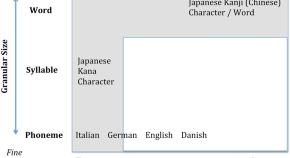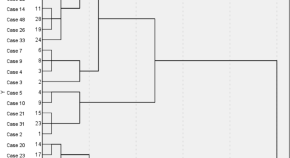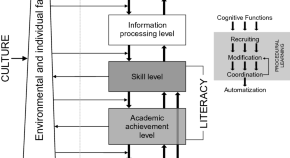Collection
Special Issue on Dyslexia and Culture
- Submission status
- Closed
Language and orthography are two crucial cultural factors that affect both reading acquisition as well as the manifestation and diagnosis of developmental dyslexia (e.g., Seymour, Aro, & Erskine, 2003; for reviews, see Ziegler & Goswami, 2005; Verhoeven, Perfetti, & Pugh, 2019). Consequently, research is focused on the question of whether characteristics of typical and impaired reading are specific to individual languages or are shared across languages and orthographies (universality vs. language-specificity, see Joshi, 2018; Landerl et al., 2013; Landerl et al., 2019; Pugh & Verhoeven, 2018). For example, several studies have shown that the relevance of pre-existing cognitive functions that play a role in dyslexia (e.g., phonological awareness and rapid automated naming) varies according to the transparency of the orthography (e.g., Landerl et al., 2019; Moll et al., 2014; Ziegler et al., 2010).
Theoretical models of dyslexia are often based on findings in alphabetic writing systems. However, alphabetic orthographies differ in how consistently graphemes are mapped to phonemes. Depending on the transparency of a language, reading acquisition proceeds at different rates (Seymore et al., 2003). Furthermore, the manifestation of dyslexia varies (e.g., Diamanti et al., 2018; Landerl et al., 1997) and the reading measures which must be assessed for diagnosis vary (e.g., Goswami, Ziegler, & Richardson, 2005; Landerl & Wimmer, 2008; Reis, Araújo, Morais, & Faísca, 2020).
In addition to alphabetic orthographies, there are numerous non-alphabetic orthographies. There have been an increasing number of findings from non-alphabetic writing systems. For example, there are several studies that test the applicability of existing models for reading and dyslexia, based on findings in alphabetic systems, in non-alphabetic languages (e.g., Joshi, 2018; Peng et al., 2021).
The aim of this issue is to bring together current research and theoretical perspectives on typical literacy acquisition and dyslexia in different languages and writing systems. Factors specific to language and writing systems, as well as universal aspects of language, may be focused on.
Specifically, we look forward to empirical and theoretical papers or reviews that explore the following questions:
- How do cultural aspects (such as economic status, milieus, educational system) affect the transmission from the neurobiological origin to the observed skill performance?
- What are the commonalities or differences in dyslexia across languages and writing systems?
- What impact does culture have on secondary symptoms?
- How does the relevance of pre-existing cognitive functions (e.g., phonological awareness or rapid automatized naming) for dyslexia differ depending on the language and writing system?
- What are the international differences or similarities in diagnostic and intervention practice?
- Do prevalence rates vary depending on language or culture?
- What role does migration play in dyslexia? Are there differences in L1 and L2 as language of instruction?
- What is the manifestation, diagnosis and/or intervention for dyslexia in multilingual systems (such as India, Catalania, Bask, Canada, Switzerland, Luxembourg, Belgium)?
- What is the manifestation, diagnosis and/or intervention for dyslexia in multilingual systems (such as India, Catalania, Bask, Canada, Switzerland, Luxembourg, Belgium)?
The Journal of Cultural Cognitive Science welcomes contributions on specific languages or cross-linguistic studies, as long as they fit the aims of the special issue. We request that authors mention the special issue in their cover letters and that they submit papers via the journal's submission portal by the deadline mentioned below. Any queries may be addressed to the Guest Editors.
Important dates:
Deadline for manuscript submission: September 30, 2022
First Review: October 30, 2022
Likely publication date: 2023
Editors
-
Thomas Lachmann
Professor of Psychology, Department of Cognitive and Developmental Psychology, University of Kaiserslautern, Germany, email: lachmann@rhrk.uni-kl.de
-
Kirstin Bergström
Senior Research Scientist, Department of Cognitive and Developmental Psychology, University of Kaiserslautern, Germany, email: kirstin.bergstroem@sowi.uni-kl.de
Articles (9 in this collection)
-
-
A cross-orthographic view of dyslexia identification
Authors (first, second and last of 5)
- Karol A. Moore
- Jialin Lai
- R. Malatesha Joshi
- Content type: Review
- Published: 01 September 2023
- Pages: 197 - 217
-
Are phonological skills as crucial for literacy acquisition in Japanese as in English as well as in accounting for developmental dyslexia in English and in Japanese?
Authors
- Taeko N. Wydell
- Content type: Review
- Open Access
- Published: 31 July 2023
- Pages: 175 - 196

-
Cognitive subtyping of university students with dyslexia in a semi-transparent orthography: what can weaknesses and strengths tell us about compensation?
Authors
- Luís Faísca
- Alexandra Reis
- Susana Araújo
- Content type: Research Paper
- Open Access
- Published: 28 May 2023
- Pages: 121 - 136

-
Phonological decoding skill in braille readers: implications for dyslexia
Authors (first, second and last of 4)
- Lindsay N. Harris
- Luis E. Lopez
- Alecia M. Santuzzi
- Content type: Research Paper
- Published: 11 May 2023
- Pages: 137 - 146

-
Characterization of reading errors in languages with different orthographic regularity: an Italian–English comparison
Authors (first, second and last of 5)
- Chiara Valeria Marinelli
- Cristina Romani
- Pierluigi Zoccolotti
- Content type: Research Paper
- Open Access
- Published: 21 April 2023
- Pages: 95 - 120

-
Dynamic tests as a language-free method for assessing reading in a multilingual setting
Authors
- Rachel E. Pye
- Huey Hwa Chan
- Content type: Research Paper
- Open Access
- Published: 27 March 2023
- Pages: 147 - 158
-
The multiple-level framework of developmental dyslexia: the long trace from a neurodevelopmental deficit to an impaired cultural technique
Authors
- Thomas Lachmann
- Kirstin Bergström
- Content type: Review
- Open Access
- Published: 14 February 2023
- Pages: 71 - 93

-
Construct validity of international literacy measures: implications for dyslexia across cultures
Authors
- Gairanlu Pamei
- Zebedee Rui En Cheah
- Catherine McBride
- Content type: Research Paper
- Published: 19 December 2022
- Pages: 159 - 173


